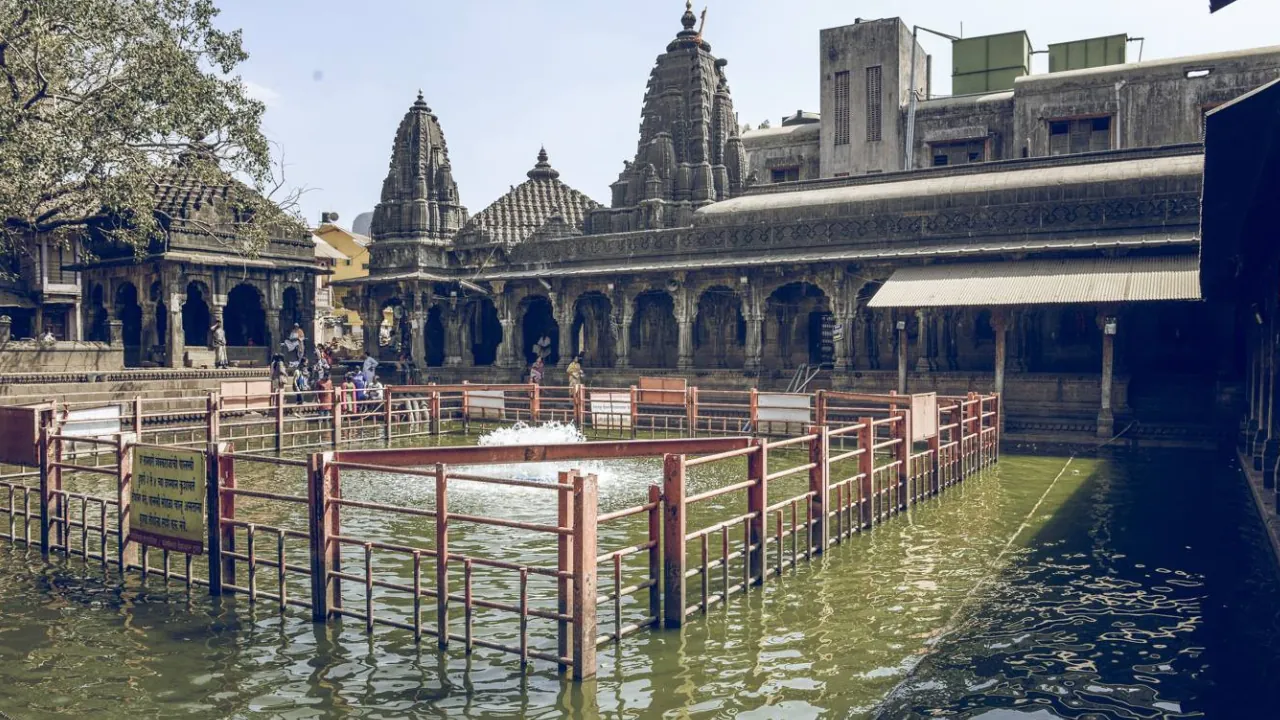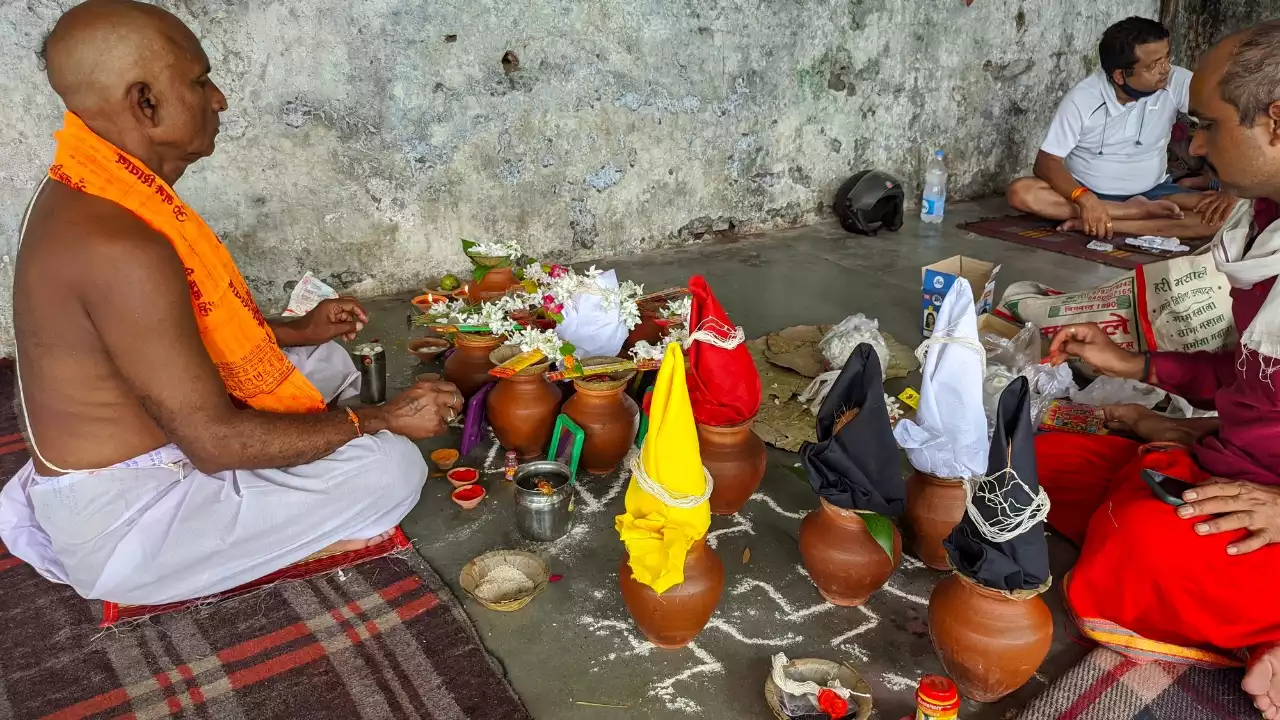Om Tryambakam Yajamahe Sugandhim Pushtivardhanam, Urvarukamiva Bandhanan Mrityor Mukshiya Maamritat!
The Divine Source: The Sanctity of Trimbakeshwar

To understand the power of a Nasik Trimbakeshwar Shradh, we must first immerse our souls in the sanctity of the place itself. Trimbakeshwar is not merely a temple; it is one of the twelve original and most powerful Jyotirlingas, the self-manifested pillars of cosmic light that are the purest forms of Lord Shiva on Earth.
The Presence of the Three-Eyed Lord
The name Tryambaka itself means “the Three-Eyed Lord.” The third eye of Lord Shiva represents the eye of wisdom, the eye that can burn away eons of karma and ignorance. To perform a rite in the presence of this Jyotirlinga is to perform it under the direct gaze of this divine, purifying wisdom. The scriptures tell us that a mere darshan (sight) of the Tryambaka Jyotirlinga is “destructive of great sins” and can bestow ultimate liberation.
The Origin of the Sacred Godavari (Gautami Ganga)
The story of Trimbakeshwar is inextricably linked to the great sage Gautama. It is said that through a divine play, Sage Gautama was wrongly accused of the sin of Go-hatya (the killing of a cow). To atone for this grave, uncommitted sin, he performed intense penance to Lord Shiva. Pleased with his devotion, Lord Shiva appeared and released a stream of the celestial Ganga from his matted locks. This stream became the mighty Godavari river, also known as the Gautami Ganga, which washed away the sage’s supposed sin.
This sacred origin story infuses the entire region with a special power of purification. To perform Shraddha here is to tap into this very stream of grace, to seek not just nourishment for the ancestors, but the washing away of any sins or karmic burdens that may be holding them back.
Kushavarta Kund: The Sacred Spring of Liberation

At the very source from which the Godavari river emerges at Trimbakeshwar lies a sacred pond, or kund, known as Kushavarta. This is the epicenter of all ancestral rites performed at this holy Tirtha.
The Altar of Purification
The Kushavarta Kund is not just a body of water; it is considered the very yoni (womb or source) of the Godavari. It is the point where Lord Shiva’s grace manifests as life-giving water. A holy dip in the Kushavarta is considered mandatory before commencing any ritual. This dip purifies the performer, making them a worthy vessel to perform the rites for their ancestors.
The Power of Tarpan and Pind Daan at Kushavarta
The Tarpan (water oblations) and Pind Daan (offering of rice balls) performed on the steps of the Kushavarta Kund hold a unique and powerful significance.
- Tarpan with Ganga’s Essence: When you offer water from the Kushavarta Kund, you are offering water from the very source of the Dakshin Ganga (the Ganga of the South). It is a direct offering of Lord Shiva’s purifying grace to quench the spiritual thirst of your ancestors.
- Pind Daan for Purification: The Pindas offered here are imbued with the energy of the Jyotirlinga and the purifying power of the Kund. The prayer associated with this offering is not just for satisfaction (tripti), but for a deep and profound purification (shuddhi) of the entire ancestral line.
Why is a Nasik Trimbakeshwar Shradh So Potent?
The synergy of the Jyotirlinga and the Kushavarta Kund creates a spiritual environment that is exceptionally powerful for several specific types of ancestral troubles.
The Ultimate Site for Kalsarp Dosh Nivaran
While this is a concept from Jyotish (Vedic astrology), it is deeply intertwined with ancestral rites at Trimbakeshwar. Kalsarp Dosh is an astrological affliction believed to arise from the karmas of ancestors, particularly those related to snakes. Trimbakeshwar is the foremost center in India for performing the Kalsarp Dosh Nivaran Puja. This puja, often performed alongside Shraddha, is a powerful remedy that seeks forgiveness on behalf of the ancestors and pacifies the serpent deities, freeing the family line from obstacles related to health, marriage, and progeny.
Relief from Unnatural Deaths and Curses
Because of its profound purifying power, Trimbakeshwar is considered an extremely potent site for performing rites for ancestors who may have died an unnatural death (durmaran) or for alleviating Pitra Dosh (ancestral curses or afflictions that affect the living descendants). The grace of the three-eyed Lord is sought to sever the bonds of suffering and grant peace to these troubled souls.
The Narayan Nagbali Puja
Another unique and powerful rite performed at Trimbakeshwar is the Narayan Nagbali Puja. This is a specific three-day ritual that combines rites for ancestors who died unnaturally (Narayan Bali) and rites to appease serpent deities for sins committed against them by ancestors (Nag Bali). It is one of the most comprehensive rituals for resolving deep-seated ancestral issues and is almost exclusively performed at this holy Tirtha.

The Sacred Procedure: A Glimpse into the Rites
While the specific details are best guided by the local Tirtha Purohits (priests of the holy site), the general flow of a Nasik Trimbakeshwar Shradh follows a sacred pattern.
- The Holy Dip (Snan): The first step is always a purifying bath in the sacred Kushavarta Kund.
- Sankalpa: On the steps of the Kund, the devotee makes their sacred vow (Sankalpa), stating their name, lineage, and the purpose of their rite.
- The Pind Daan: The offering of Pindas is made, with specific mantras chanted by the priest, invoking the ancestors to accept the offering.
- Darshan of the Jyotirlinga: After the rites at the Kund, the pilgrim proceeds to the main temple for the darshan of Lord Tryambakeshwar. This act of seeing the divine form seals the blessings of the ritual.
- Specialized Pujas (if required): If the pilgrim is also performing rites like Kalsarp Dosh Nivaran or Narayan Nagbali, these are conducted by specialized priests in dedicated areas around the temple.
A Pandit’s Final Counsel: The Path of Purification
When to Go?
While Trimbakeshwar is eternally auspicious, performing rites during Pitrupaksha multiplies the benefits manifold. Other auspicious times include Amavasya (new moon day), solar/lunar eclipses, and the holy month of Shravan (the month of Lord Shiva).
What if I Cannot Travel?
The heart’s devotion can cross any distance. If you are unable to make the physical journey, you can still connect with the grace of this holy Tirtha.
- Mental Pilgrimage (Manasika Yatra): During your Shraddha at home, close your eyes and in your Sankalpa, mentally transport yourself to the Kushavarta Kund. Visualize the Jyotirlinga. Offer your prayers with the strong intention that they be accepted at Trimbakeshwar.
- Rites on Your Behalf: In this modern age, it is a great blessing that you can have these powerful and complex rites performed on your behalf by qualified priests at Trimbakeshwar. Reputable organizations like pitrupaksha.org offer services to facilitate these pujas, allowing you to participate remotely and receive the full blessings for your ancestors.
Conclusion: A Shraddha of Deep Purification and Grace
To perform a Nasik Trimbakeshwar Shradh is to choose a path of profound purification. It is a journey to the very source of a sacred river, to the feet of a mighty Jyotirlinga. While other Tirthas may be known for granting worldly boons or final liberation, Trimbakeshwar’s unique power lies in its ability to cleanse, to heal, and to resolve the most difficult ancestral karmas.
It is an offering that seeks to wash away the sins and sufferings of your ancestors with the purifying grace of Lord Shiva himself, allowing them to proceed on their journey, lightened and liberated. It is an act of deep compassion, a powerful spiritual remedy, and a testament to the boundless mercy of the three-eyed Lord.
Aashirvaad.
May Lord Tryambakeshwar accept your offerings, may the sacred waters of the Godavari purify your lineage, and may your ancestors attain the highest state of peace.
